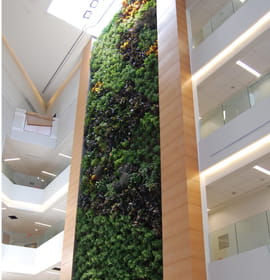Drexel to Open Nations First University Facility that Includes a Biowall for Improved Air Quality

- Drexel Selects New, World-Class Life Sciences Building at 3201 Cuthbert Street for Medical Research Operations
- Breakthrough on Gene Therapy for Hereditary Spastic Paraplegia
- Drexel Environmental Collaboratory Releases Cross-Sector Findings on Severe Weather Recovery Challenges
- Drexel Launches the Manuel Stamatakis Center for Alternative Investments at the LeBow College of Business

Drexel University opened the doors to its new science building, Pennsylvania’s newest landmark for scientific research and the future of integrated science, on September 20. The $69-million Constantine N. Papadakis Integrated Sciences Building serves as the new home of Drexel’s biology department and includes North America’s largest living biowall, the only such structure at a U.S. university. The biowall, a 75-ft. high wall of plants, serves as a biological air filter, demonstrating Drexel’s longstanding commitment to sustainability and progressive research.
"The form and function of the Papadakis Integrated Sciences Building have grown out of Drexel's commitment to environmental sustainability and biological science," said Drexel President John A. Fry. "This unique facility serves as a hub for some of Drexel's most important research and innovation, while responding to the demands of good campus stewardship."
The 150,000 square-foot building, located at 33rd and Chestnut Streets, was designed by world-renowned architects Diamond & Schmitt. It is expected to become Drexel’s first building to achieve LEED certification by the U.S. Green Building Council, and is also anticipated to receive at least a 3 Green Globes® rating from the Green Building Initiative.
Living Wall of Plants Improves Indoor Air Quality and Provides Research Material
The biowall, designed and installed by NEDLAW Living Walls and located in the atrium of the Papadakis Building, measures 75 ft. tall and 22 ft. wide and is five stories high. The plant installation was conducted by Parker Plants, who will also maintain the wall. Biowalls of this type were first introduced in Canada by Diamond & Schmitt Architects. The wall uses plants’ natural respiratory properties to cool the indoor air in the summer and function like a humidifier in the winter. Contaminated air is drawn through the roots of the plants where microbes help to remove particulates and volatile compounds. At Drexel, professors and students will use the wall to examine its effect on the interior atmosphere and its potential health benefits for commercial and academic applications. Read more about the biowall and related research at http://drexel.edu/coas/research/pisb/BioWall/.
Building Design Inspired by Science and Scholarship
After choosing Toronto's Diamond & Schmitt Architects, Dr. Aleister Saunders, an associate professor in the College of Arts and Sciences, worked with the Toronto designer and H2L2, the local architects who oversaw construction. The value of their collaboration is visible throughout the building, including the 44 research and teaching laboratories for biology, organic chemistry and biomedical engineering. Natural light fills all of the labs, and open spaces throughout the building encourage discussion and collaboration among researchers.
A transparent glass cylinder four stories high comprises small lounges or interactive “collaboratories” where students and faculty can network on the building’s second, third, and fourth floors.
“The essence of this structure—a place for faculty and students to meet, to discuss ideas, and to be inspired—is felt from the open atrium up to the elegant skylights. I am proud and excited to welcome our students into this new space,” said Dr. Donna Murasko, dean of the College of Arts and Sciences.
Landmark in the Legacy of Constantine N. Papadakis
The building is named for the late Drexel University President Constantine N. Papadakis, whose legacy can easily be witnessed across Drexel’s three campuses: buildings by renowned architects, a law school, a medical school, new construction and an even more vibrant University City Main campus. Known throughout the national academic community as an innovator and the chief executive who turned around two venerable institutions—Drexel and the former Allegheny University of the Health Sciences, Papadakis was among the longest-serving presidents in higher education. His arrival at Drexel in 1995 ushered in an era of unprecedented growth and excellence. He died April 2009.
Financial Assistance for the building was provided by the Commonwealth of Pennsylvania, Redevelopment Assistance Capital Program, Honorable Governor Edward Rendell.
Visuals
Browse available photos in the following sets:
- Building Nearing Completion (early August, 2011)
- Late in Construction (July 19, 2011)
- Scientists and Students in the Building (September, 2011)
- Biowall - Installation and Researchers (July, 2011)
News media contact:
Niki Gianakaris, director, Media Relations, Office of University Communications
215-895-6741, 215-778-7752 (cell) or ngianakaris@drexel.edu
Rachel Ewing, News Officer, Office of University Communications
215-895-2614 or raewing@drexel.edu
In This Article
Drexel News is produced by
University Marketing and Communications.